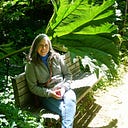Getting Ready to Monitor Monarchs
Despite the generally cold and wet spring we’ve had, the milkweed has popped up in my gardens. The common milkweed is already about six inches tall and my rose milkweed has germinated even though it is still tiny. An unknowing eye would think it was a weed. I know better and didn’t pull it out. Our third type of milkweed is on a hillside berm near the road. There we have whorled milkweed that I discovered last year. Given the extensiveness of the stems, I would hedge a bet it’s been there for years, I just didn’t know it.
I’ve been involved in conserving monarch habitats for the last twenty years. Last year, I ventured beyond my local community to a plot of land owned by the state — Rush Creek State Natural Area. Venturing there took me to another county south of where I live by about an hour’s drive. It was remote. Last June, I met an awesome young biologist from the Wisconsin Department of Natural Resources who gave me some training at the site. After that, I was on my own. I took my friend Lisa and my son Charlie for future monitoring sessions. Since it was remote, I wanted to have another person with me. Data was gathered on the egg and caterpillar stages, the vegetation within my assigned plot, as well as any flying monarchs that I noted. The field was planted in soybean, so there was only one stem of milkweed. In general, the data collecting experience was disappointing, but the purpose of monitoring remained important to me.
This year, due to our move to yet another Wisconsin county, now in the Northwoods, I had to think about how I was going to manage my monarch monitoring. I wanted to continue to work with the IMMP (Integrated Monarch Monitoring Program) but could not foresee traveling four hours to the site I used last year. Still, when I got noticed the refresher training videos were posted, I took two hours out of my packing time to watch them.
During the viewing, I realized that I could monitor for monarchs at one of their random block sites near our cabin. So much work has been done to randomize and provide sites that can be adopted and monitored that you can find one virtually anywhere in the contiguous U.S. I was able to zoom into our county up North and find a plethora of unadopted sites. I have picked a right of way on a country road. Since I have a few questions, I contacted the IMMP coordinator, since this monitoring experience will be different from last year for me. Soon, I’ll be able to register this site as adopted (by me).
I also decided that I am going to monitor a self-selected site on our ridge top, remnant prairie. In this case, I have to go to our land, measure a plot, find the GPS coordinates, and register it with the IMMP. I know there are milkweed and nectar plants on our land, and therefore, should be monarchs visiting. Once I choose the coordinates, I have to stick with them for my data collection. It will be interesting for me to collect data on two different parcels of land this year. As you can tell, I’m getting geared up and excited to monitor for monarchs!
Lastly, recent tag recoveries were reported by Monarch Watch. I looked with anticipation to see if any of the monarchs I tagged in my yard (11 reared and 1 wild) made it to Mexico. Sadly, it appears not. I had six additional monarchs that I did not tag due to a family medical emergency, so I can still hope one of those completed their migration last fall.
This week I was honored to have my volunteer work for monarchs featured in the annual report (2021) from the Natural Resources Foundation of Wisconsin! My conservation work for monarchs has provided me with a great deal of satisfaction over the last two decades. It was a nice (and rare) reward to see that a state conservation organization recognized and valued my time as a monarch conservationist. I was honored and grateful to be asked to provide an interview about my passion for these small, iconic pollinators. I look forward to another year working for monarchs! The time is almost here!
Originally published at http://theapplesinmyorchard.com on May 26, 2022.
